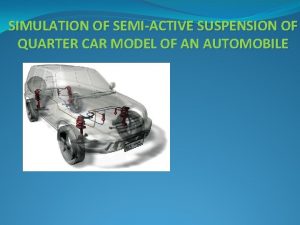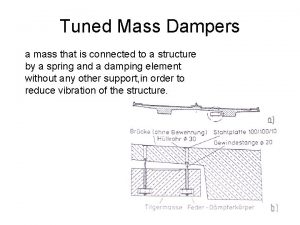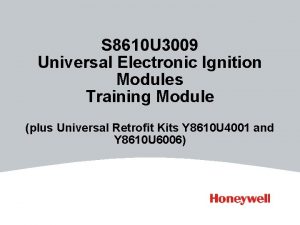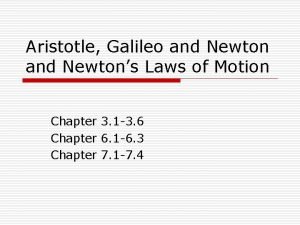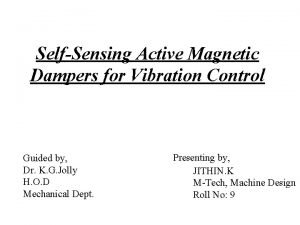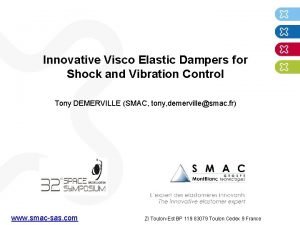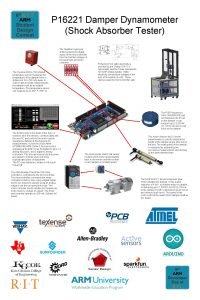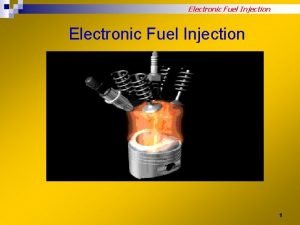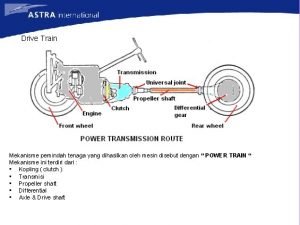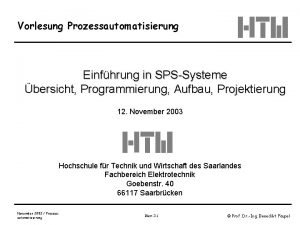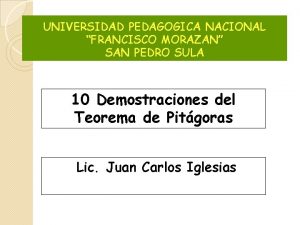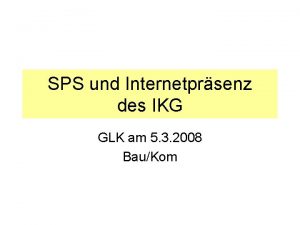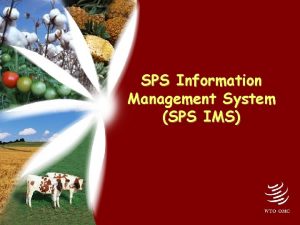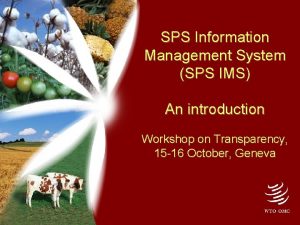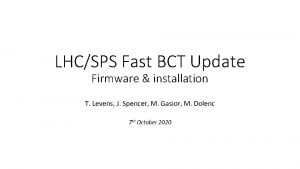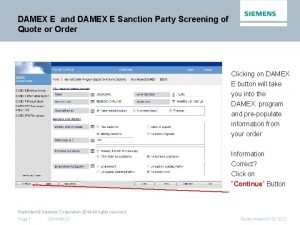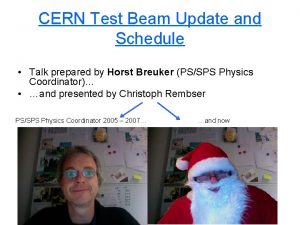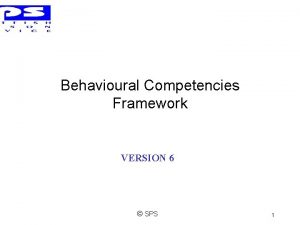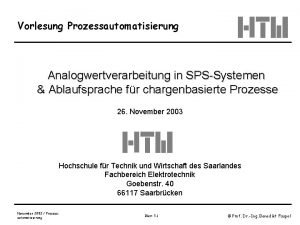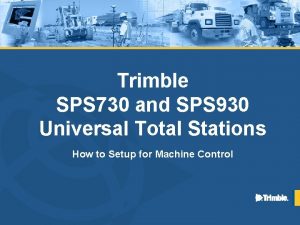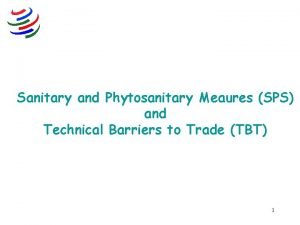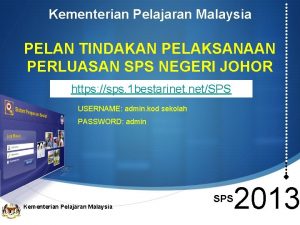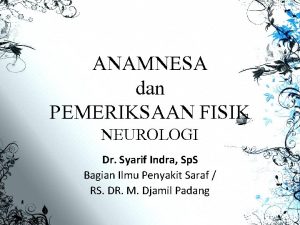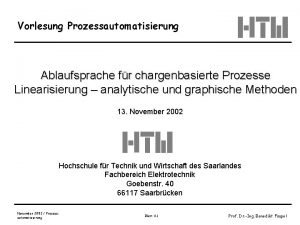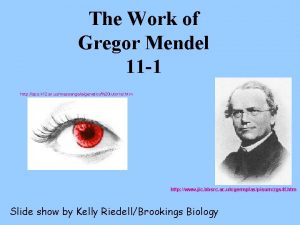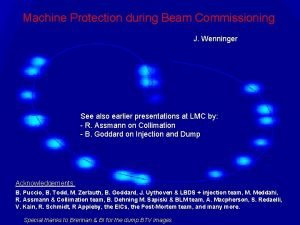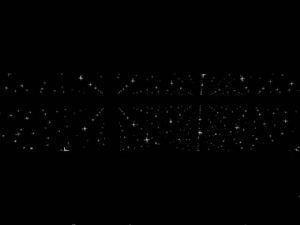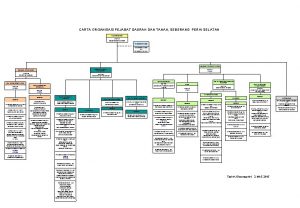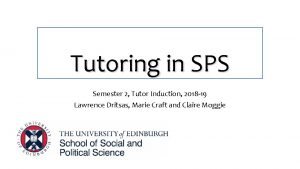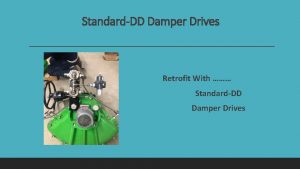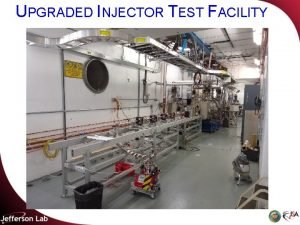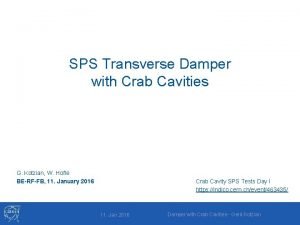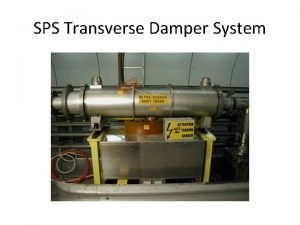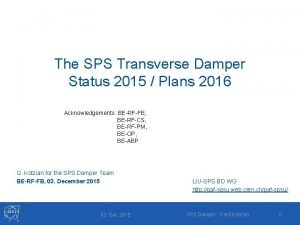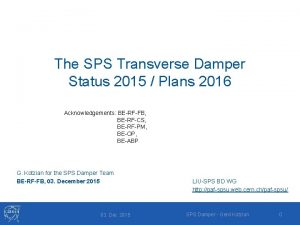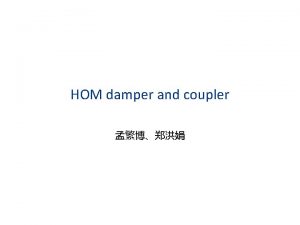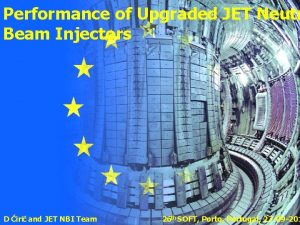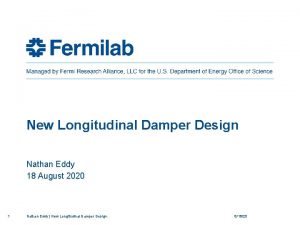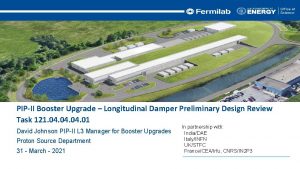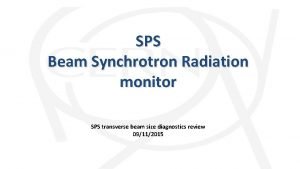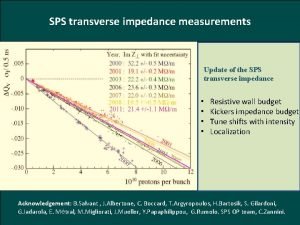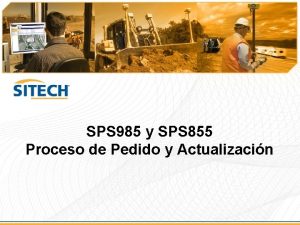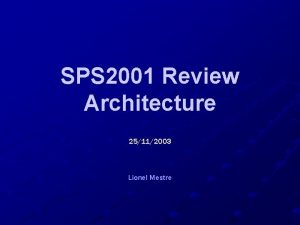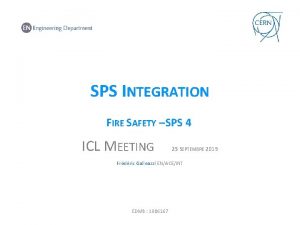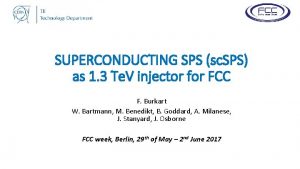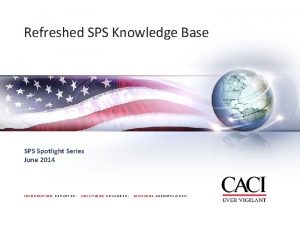Design and Performance of the Upgraded SPS Damper





![cfv-ba 2 -alltrdamp[hv]1 cfv-ba 2 -alltrdamp[hv]2 SPS Damper Loops p. LHC RF Frontend 200 cfv-ba 2 -alltrdamp[hv]1 cfv-ba 2 -alltrdamp[hv]2 SPS Damper Loops p. LHC RF Frontend 200](https://slidetodoc.com/presentation_image_h2/782c2489a35f450209aceb29d0080ccf/image-6.jpg)
![cfv-ba 2 -alltrdamp[hv]1 cfv-ba 2 -alltrdamp[hv]2 SPS Damper Loops p. LHC RF Frontend 200 cfv-ba 2 -alltrdamp[hv]1 cfv-ba 2 -alltrdamp[hv]2 SPS Damper Loops p. LHC RF Frontend 200](https://slidetodoc.com/presentation_image_h2/782c2489a35f450209aceb29d0080ccf/image-7.jpg)







![Control signals (FESA) – in LSA: DSPU[1, 2]Eq. Control DSPU[1, 2]Mask DSPU[1, 2]Switch. Ctrl Control signals (FESA) – in LSA: DSPU[1, 2]Eq. Control DSPU[1, 2]Mask DSPU[1, 2]Switch. Ctrl](https://slidetodoc.com/presentation_image_h2/782c2489a35f450209aceb29d0080ccf/image-15.jpg)






![2014 Performance - p. FT [18. 9. 2014] SUM DELTA 13. Feb 2015 • 2014 Performance - p. FT [18. 9. 2014] SUM DELTA 13. Feb 2015 •](https://slidetodoc.com/presentation_image_h2/782c2489a35f450209aceb29d0080ccf/image-22.jpg)

![LHC 25 ns beam as seen by p. FT [18. 9. 2014] SUM • LHC 25 ns beam as seen by p. FT [18. 9. 2014] SUM •](https://slidetodoc.com/presentation_image_h2/782c2489a35f450209aceb29d0080ccf/image-24.jpg)
![2014 Performance - p. LHC Logbook: SPS [Thursday 09 -Oct-2014 Night] 00: 27 HORIZONTAL 2014 Performance - p. LHC Logbook: SPS [Thursday 09 -Oct-2014 Night] 00: 27 HORIZONTAL](https://slidetodoc.com/presentation_image_h2/782c2489a35f450209aceb29d0080ccf/image-25.jpg)
















- Slides: 41

Design and Performance of the Upgraded SPS Damper after LS 1 Acknowledgements: BE-RF-FB, BE-RF-CS, BE-RF-PM, BE-BI, BE-OP, BE-ABP, TN-EL G. Kotzian for the Damper Team BE-RF-FB, 13. February 2015 13. Feb 2015 MSWG https: //indico. cern. ch/event/367094/ SPS Damper - Gerd Kotzian 0

Transverse Damper in General The transverse damper is a feedback system: it measures the bunch-bybunch oscillations and damps them by fast electrostatic kickers. Ø D. Valuch, “TRANSVERSE FEEDBACK: HIGH INTENSITY OPERATION, ABORT GAP CLEANING, INJECTION GAP CLEANING AND LESSONS FOR 2012”, in LHC Beam Operations Workshop, Evian 2011. Ø Key elements: Ø Beam position monitor(s) Ø Signal processing system Ø Power amplifiers Ø Electrostatic kickers Ø Key parameters: Ø Feedback loop gain, phase, and total loop delay Ø Kick strength Ø System bandwidth 13. Feb 2015 SPS Damper - Gerd Kotzian 1

Outline Objective: Have a look at the upgraded SPS Damper and its internal structure, to gain insight in what/how the damper can be used e. g. for MDs. Damper, not Dumper Structure: o Design of the upgraded SPS Damper o 2014 Performance o Outlook for 2015 13. Feb 2015 SPS Damper - Gerd Kotzian 2

Former SPS Transverse Feedback System o Last upgrade 1997 -2000 in preparation of the SPS as LHC injector o damping of injection errors and cure of resistive wall impedance driven coupled bunch instability (threshold ~5 x 1012 protons total intensity) o operates since 2001 between lowest betatron frequency and 20 MHz (V & H plane) to damp all possible coupled bunch modes at 25 ns bunch spacing o handles large injection errors of the order of several mm o Tetrode amplifiers with two tubes drives kicker plates in push-pull configuration installed in tunnel under kicker, 200 W drive power per tetrode, 3 k. Hz to 20 MHz o Technology of electronics of system used in SPS until 2012 dates from late 1990’s 13. Feb 2015 SPS Damper - Gerd Kotzian 3

Scope and Motivation for SPS damper upgrade under LIU Why LS 1? • sharing pick-ups with Orbit System (MOPOS) from Beam Instrumentation Group incompatible with MOPOS upgrade • requirements for single bunch damping for protons used for LHC p-ion Physics (closer spaced proton bunches, 100 ns) • ions injection damping with fixed frequency scheme, closer spaced batches • individual bunch damping for crab cavity studies not possible with previous system (sampling was not synchronous with bunch in previous system) • LHC doublet scrubbing beam incompatible with previous system • controls with G 64 chassis and MIL-1553 (a. k. a. MMI) became obsolete new controls for power system and LLRF, new RF function generators 13. Feb 2015 SPS Damper - Gerd Kotzian 4
![cfvba 2 alltrdamphv1 cfvba 2 alltrdamphv2 SPS Damper Loops p LHC RF Frontend 200 cfv-ba 2 -alltrdamp[hv]1 cfv-ba 2 -alltrdamp[hv]2 SPS Damper Loops p. LHC RF Frontend 200](https://slidetodoc.com/presentation_image_h2/782c2489a35f450209aceb29d0080ccf/image-6.jpg)
cfv-ba 2 -alltrdamp[hv]1 cfv-ba 2 -alltrdamp[hv]2 SPS Damper Loops p. LHC RF Frontend 200 MHz SPS Damper Loops p. FT SPS Damper Loops Ions Baseband Frontend RF Frontend 200 MHz FSK SPS Damper Loops Scrub Stripline pickup processing Baseband Frontend (40 MHz) BPM Proc. ADC 1 Beam Pos 1 DSPU 1 DAC 1 ADC 2 Beam Pos 2 DSPU 2 DAC 2 p. LHC, Scrub Ions SURFACE BA 2 TUNNEL LSS 2 Electrostatic PU processing BW ~100 MHz BEAM BPM Proc. PU 1 PU 2 p. FT 13. Feb 2015 Switch M 1 p. LHC Switch M 2 p. LHC Damper Signal Selector p. FT from BBQ Ions from VNA Scrub PLC 1 200 W Driver Damper Power System Final Stage KICKER 1 SPS Damper - Gerd Kotzian PLC 2 KICKER 2 5
![cfvba 2 alltrdamphv1 cfvba 2 alltrdamphv2 SPS Damper Loops p LHC RF Frontend 200 cfv-ba 2 -alltrdamp[hv]1 cfv-ba 2 -alltrdamp[hv]2 SPS Damper Loops p. LHC RF Frontend 200](https://slidetodoc.com/presentation_image_h2/782c2489a35f450209aceb29d0080ccf/image-7.jpg)
cfv-ba 2 -alltrdamp[hv]1 cfv-ba 2 -alltrdamp[hv]2 SPS Damper Loops p. LHC RF Frontend 200 MHz SPS Damper Loops p. FT SPS Damper Loops Ions Baseband Frontend RF Frontend 200 MHz FSK SPS Damper Loops Scrub Stripline pickup processing Baseband Frontend (40 MHz) BPM Proc. ADC 1 Beam Pos 1 DSPU 1 DAC 1 ADC 2 Beam Pos 2 DSPU 2 DAC 2 p. LHC, Scrub Ions SURFACE BA 2 TUNNEL LSS 2 Electrostatic PU processing BW ~100 MHz BEAM BPM Proc. PU 1 PU 2 p. FT 13. Feb 2015 Switch M 1 p. LHC Switch M 2 p. LHC Damper Signal Selector p. FT from BBQ Ions from VNA Scrub PLC 1 200 W Driver Damper Power System Final Stage KICKER 1 SPS Damper - Gerd Kotzian PLC 2 KICKER 2 6

Power System Consolidated new process control based on PLC in BA 2 FESA remotely accessible EM field simulation of kicker 13. Feb 2015 SPS Damper - Gerd Kotzian Tetrode amplifier in SPS LSS 2 7

6 x Beam Position Monitors installed in LS 1 RF Faraday cage • 2 BPCR (H/V) for LHC type beams (couplers maximum ZT @ 200 MHz) • 2 BPH electrostatic PU (p. FT) • 2 BPV electrostatic PU (p. FT) SPS Transverse FB • all BPMs re-cabled with 7/8 -inch smooth wall coaxial cables during LS 1; [length ~250. . 700 m] • BPH/BPV: electronics and amplifiers in the tunnel tested and verified; "hot-spares" readily checked and kept in the tunnel • BDH / BDV kickers unchanged 13. Feb 2015 BPCR. 221 Approximate transport delays: Device Delay BPH. 202 2. 48 μs BPCR. 214 0. 97 μs BPH. 204 2. 24 μs BPCR. 221 0. 82 μs BPV. 205 2. 12 μs H 1/H 2/V 1 1. 57 μs BPV. 207 1. 88 μs V 2 1. 31 μs SPS Damper - Gerd Kotzian 8

Analog Frontend Control / External Control o External control (only LHC type beams): • • • o Two analog frontend types: • • o • LO 200 MHz 120 MHz RF: switching attenuators + amp, delay matched dynamic range: -29 d. B to + 10 d. B. BB: variable gain amplifier (VGA) dynamic range: -27. 4 d. B to + 26 d. B. 120 MHz Frontend protection circuitry • input overdrive protection: fast enables all attenuators, disables all amplifiers no recovery cycle is lost! • reports as ALARM in LASER; action required! • • o RF frontend, used for p. LHC and Ions, LO = 200 MHz, I/Q components Baseband frontend (BB), used for p. FT and Scrub, only I-component Input gain control: • o disable 50 Ohm input termination disable attenuation enable amplifier ADC overflows (8 x) • in LSA report as WARNINGS in LASER 13. Feb 2015 RF frontend schematic FEBb. Gain FERf. GAIN FESelect SPS Damper - Gerd Kotzian 9

Beam Position Block (Beam. Pos) o 2 Beam. Pos Blocks per damper loops module = one per pick-up input in LSA o I/Q inputs of SUM and DELTA signals • o o o Beam. Pos 1 Ppm. Ctrl Beam. Pos 2 Ppm. Ctrl Switch. Control Co. Re – Conditioning and Resampling • I/Q phase rotation • Down sampling: 120 MSPS 40 MSPS (25 ns bunch sync) Clock domain crossing • o in ADC sampling clock domain, hence subject to delay adjustment from 2 x ADC input clocks (delayed per pick-up) to synchronous reference clock (undelayed) Normalization • position calculation (in-phase) • “quadrature position” indicating head-tail activity • bypass mode in case of DELTA processing (p. FT) Overflows (Sum, Delta, Norm) • report as WARNINGS in LASER 13. Feb 2015 SPS Damper - Gerd Kotzian 10

Sensitivity of Frontend to intrabunch motion (LHC ADT) Symmetric (even mode) Excitation Anti-symmetric (odd mode) Excitation Ø indication of odd-mode oscillations! Ø re-evaluate for SPS case NB: although higher even modes visible the damper is acting only in baseband up to 20 MHz – for damping of higher frequencies wideband transverse feedback 13. Feb 2015 22. Jan 2014 SPS Damper - Gerd Kotzian Sensitivity of LHC ADT to intra-bunch motion 11

Visualization of Bunch Motion Rapid identification of • • quiet bunches with transverse center of mass motion bunches with head tail motion bunches with combination of center of mass and headtail motion with correlation QDELTA Example: LHC run 2012 IDELTA 13. Feb 2015 SPS Damper - Gerd Kotzian 12

DSPU – Digital Signal Processing Unit o 2 DSPUs per damper; one per module; two inputs o Signal processing o o • Notch filter • Hilbert phase shifter / PU vector sum • Bunch masking • phase equalizer FIR (up to 64 taps), linearize phase of power system ≈ low pass 1 st order, cutoff freq. (-3 d. B) @ 4. 5 MHz operated at 40 MSPS better resolution at lower frequencies • gain equalizer (up to 64 taps), digital low pass shaping output signal operated at 120 MSPS Clock domain crossing • upsampling: 40 MSPS 120 MSPS (Interpolated by gain equalizer = LP FIR) • from synchronous reference clock (undelayed) to 2 x DAC output clocks (delayed) implements actual 1 -turn delay DSPU[1, 2]Eq. Control DSPU[1, 2]Mask DSPU[1, 2]Switch. Ctrl digital low pass, fc ≈ 16 MHz Switches • o in LSA: phase equalizer FIR, comp. 1 st order 4. 5 MHz Notch. Enable, Phase. Shift. Ena, Ch 1/Ch 2 enable, Loop/Aux enable, Digital Loop Enable Overflows • report as WARNINGS in LASER 13. Feb 2015 SPS Damper - Gerd Kotzian 13
![Control signals FESA in LSA DSPU1 2Eq Control DSPU1 2Mask DSPU1 2Switch Ctrl Control signals (FESA) – in LSA: DSPU[1, 2]Eq. Control DSPU[1, 2]Mask DSPU[1, 2]Switch. Ctrl](https://slidetodoc.com/presentation_image_h2/782c2489a35f450209aceb29d0080ccf/image-15.jpg)
Control signals (FESA) – in LSA: DSPU[1, 2]Eq. Control DSPU[1, 2]Mask DSPU[1, 2]Switch. Ctrl Functions (from RFFG) - in LSA: DSPU – Digital Signal Processing Unit Excitation input (DDS) FGCPpm. Control Loops. Control 13. Feb 2015 Use Digital Loop Switches preferred way to disable damper SPS Damper - Gerd Kotzian 14

Default Timings o RT task (PPM READ/WRITE) o 120 MHz resync (200 ms before INJ) o f. Rev resync (flywheels in 5 clock domains) o start function generation (RFFG) o close damper loops H 1/H 2 resp. V 1/V 2 before injection o scope trigger, o VNA trigger, o observation trigger + MEM readout task o open damper loops in LSA: Loops. Control Loop Control: o Use Digital Loop Switches (preferred way to disable damper) o Loop ON & OFF timings are required to ensure proper behaviour do not disable 13. Feb 2015 SPS Damper - Gerd Kotzian 15

Clock Distribution: f. RF and f. REV o o new fiber optic links between Faraday cage in BA 3 and Damper racks in BA 2 • new fibers installed during LS 1 • VME FO modules (RX/TX) • status + diagnostics available (FESA) local clock distribution in BA 2 • o o o active splitting (NIM modules) 1. 9 km fiber links local clock generation • 120 MHz out of 200 MHz f. RF • beam synchronous, for sampling ADCs and DACs • resync once per cycle to f. REV before injection expect over year 20 degrees drift @200 MHz long-term measurement Winter Summer f. REV resynchronization • 5 clock domains (Syn. Clk, ADC 1, ADC 2, DAC 1, DAC 2) • one flywheel per clock domain, • resync once per cycle to f. REV before injection in LSA: CLOCKControl CLOCKPpm. Control Monitoring possibilities no Alarms (ion cycle does not transmit f. RF all the time) 13. Feb 2015 SPS Damper - Gerd Kotzian 16

Closed loop delay compensation o 13. Feb 2015 SPS Damper - Gerd Kotzian 17

Functions Distribution o o o 3 RFFGs: Horizontal / Vertical / e. Xperimental • 32 bit Serial Control Link, 16 bit payload (32 bit optional) • 1 ms update rate (up to 16 k. Hz) 16 functions (PPM): gain, phase, PU mixing coeffs, delay • daisy-chained through all 4 damper modules via the backplane: RFFG p. FT p. LHC Scrub Ions RFFG • only 1 module active (ACK) at a time, • frames return as NACK if no module is active • tricky if 2 or more modules active at the same time (must be avoided) • static value output vs. functions (LSA selectable) in LSA: ALLRf. Func. Gen/ Functions FGCPpm. Control Frontpanel serial links (16 bit) • 4 x setpoint values to Power Converters • send as hexadecimal numbers: 0 x 4300 == 4. 3 k. V • voltages out of range will trip the power system EXPERT SETTING • care must be taken when power cycling these crates: cfv-ba 2 -alltrdamph 1, cfv-ba 2 -alltrdampv 1, if in doubt set power system first to LEVEL 1 13. Feb 2015 in LSA: SPS Damper - Gerd Kotzian ALLRf. Func. Gen/ FPSLStatic. Values 18

Damper Signal Selector (DSS) o 2 DSS (H/V), with 2 fully independent channels, to select between inputs Module 1 and Module 2 o 4 + 1 + 1 loop inputs per output o in LSA: • 4 damper modules (p. LHC, p. FT, Ions, Scrub) • 1 e. Xperimental module for developments and MDs (Xper) • 1 transverse excitation input (BBQ Marek Gasior) • 1 external VNA input ALLDamp. Sig. Sel/ Switch. PPMControl selectable VNA output • allows for open loop TF measurements • allows for closed loop TF measurements • measure one plane, i. e. both modules and pick-ups with one VNA setup + remote controllable switching Logbook: SPS [Thursday 09 -Oct-2014 Night] 00: 27 Damper commissioning and setting-up for LHC beam on MD 1: parameters for all 4 dampers H 1/H 2/V 1/V 2 adjusted. Finedelay for pick-ups 214 and 221 in H/V determined using the beam transfer function measurement. Input dynamic range adjusted based on +/-5 mm bumps and nominal per bunch intensity (1. 15 e 11 ppb, 48 bunches). Today, for the very first time, the system was set-up completely remotely from the CCC. 13. Feb 2015 SPS Damper - Gerd Kotzian 19

Acquisition and Observation o o o provide means to expert users/piquets for diagnostics • triggered by timing freezes acquisition buffers in all channels • 7 Channels, (16 buffers) − 1 OBS channel (4 buffers, selectable sources) − 6 channels per clock domain (2 buffers each, dedicated) I/Q data for sum/delta inputs (per pick-up) • position data (+head-tail component) • probe various DSPU internal signals • 40 MSPS, 4 buffers, each 2 MSamples, or ~ 2000 turns Buffer. Setting Buffer. Select. OBS Buffer. Acquisition INJECTION DAMPING (damper, chromaticity) OBS data sources available • in FESA 3: approx. 1 ms Dedicated channels: 120 MSPS • 2 buffers per channel, each 4095 samples • 1 -turn data (2772 slices) per ADC and DAC channel • adjustment of sampling delay • clock tagging (bunch 0) NB: constant data stream available (in the future) Obs. Box! (LMC March 13 th 2015) 13. Feb 2015 SPS Damper - Gerd Kotzian 20
![2014 Performance p FT 18 9 2014 SUM DELTA 13 Feb 2015 2014 Performance - p. FT [18. 9. 2014] SUM DELTA 13. Feb 2015 •](https://slidetodoc.com/presentation_image_h2/782c2489a35f450209aceb29d0080ccf/image-22.jpg)
2014 Performance - p. FT [18. 9. 2014] SUM DELTA 13. Feb 2015 • Injection of fixed target proton beam • Intensity about 10 -20% of nominal • more charges towards the end of the batch • oscillating in HORIZONTAL SPS Damper - Gerd Kotzian 21

2014 Performance - p. FT VNA HORIZONTAL 3 MHZ LEGEND: YELLOW delta signal pickup 202; BLUE kick voltage module 1; GREEN kick voltage module 2 1 ms RECOHERENCE HORIZONTAL • • open loop BTF measurement sweep of two betatron lines adjustments using phase setting and loop delay synchrotron sidebands seen 1 ms Logbook: [Monday 27 -Oct-2014, 23: 15] approx. 0. 7 ms VNA VERTICAL 3 MHZ VERTICAL 13. Feb 2015 SPS Damper - Gerd Kotzian 22
![LHC 25 ns beam as seen by p FT 18 9 2014 SUM LHC 25 ns beam as seen by p. FT [18. 9. 2014] SUM •](https://slidetodoc.com/presentation_image_h2/782c2489a35f450209aceb29d0080ccf/image-24.jpg)
LHC 25 ns beam as seen by p. FT [18. 9. 2014] SUM • Injected batch of 12 LHC bunches, • spaced by 25 ns, • intensity about 1. 1 x 1011 ppb. Saturation phenomena develops 10 turns after the injection. DELTA [19. 9. 2014] The effect comes from an electron cloud and the amplifiers handle it with no problems. It runs like this since 2008. 13. Feb 2015 SPS Damper - Gerd Kotzian 23
![2014 Performance p LHC Logbook SPS Thursday 09 Oct2014 Night 00 27 HORIZONTAL 2014 Performance - p. LHC Logbook: SPS [Thursday 09 -Oct-2014 Night] 00: 27 HORIZONTAL](https://slidetodoc.com/presentation_image_h2/782c2489a35f450209aceb29d0080ccf/image-25.jpg)
2014 Performance - p. LHC Logbook: SPS [Thursday 09 -Oct-2014 Night] 00: 27 HORIZONTAL DAMPER OFF DAMPER ON VERTICAL 13. Feb 2015 SPS Damper - Gerd Kotzian 24

LHC Pilot Setting Up: Open Loop BPCR. 214. V o OL-Ver 100 k. HZ o OL-Ver 4 MHZ [07. 12. 2014] 18: 49 19: 35 13. Feb 2015 o OL-Ver 1 MHZ o OL-Ver 6 MHZ o o OL-Ver 2 MHZ OL-Ver 10 MHZ 5 -10 min/measurement OPTIMIZE … ? SPS Damper - Gerd Kotzian 25

p. LHC. MD 3 - Observations • • Data during MD 3 cycle (25 ns, no splitting) Recorded: 4 th injection (@ 10800 ms) 13. Feb 2015 SPS Damper - Gerd Kotzian 26

1 turn ~70 turns activity in the last injected batch (+1 st order roll-off of damper gain) 1 st batch 13. Feb 2015 2 st batch 3 rd batch 4 th batch SPS Damper - Gerd Kotzian 27

Status End 2014 o Completely new system built and taken into operation (March – Dec) o Commissioning challenges: • Issue with p. FT isolation transformers of all PU inputs had polarity swapped • FESA 3 class on-the-fly bug-fixing • at the time no high-level software … all setting-up done in FESA • All sorts of troubles with the internal observation system … “… driving your car with windows painted black – you have to get off to see if your lights are on!” • Setting up of feedback parameters requires stable beam conditions (here I’m not referring to “stable beam”); [tune, chromaticity, injection timing, bucket selection, … ] • Damper switched OFF by CCC while we were setting up things in BA 2 …? !! … communication issue 13. Feb 2015 SPS Damper - Gerd Kotzian 28

Outlook for 2015 – SCRUBBING o Evaluate scrubbing module Investigate on “phase behaviour” • compare Scrub vs. p. LHC • sharing same PU and same power system, expect same behaviour … o Move to full I/Q signal processing • currently the scrubbing module is too sensitive to sampling delay • implement in analog, requires modification of HW • DDC - digital down conversion, modification of FW o run Scrub + p. LHC damper in parallel • Scrub active during splitting process (40 MHz present) • p. LHC kicks in once splitting is complete (200 MHz restored) single bunch doublet “PU signal” Analog signals before digitization: 25 ns spaced doublets (during LAB testing) 200 MHz BP filtered 40 MHz BP filtered (120 MHz sampled) 13. Feb 2015 SPS Damper - Gerd Kotzian 29

Outlook for 2015 – USER INTERFACE o o o refactoring damper loops FESA class V 2. 0 • firmware: excess functionality removed (mainly housekeeping, no change in signal processing!) • testing using the Xperimental crate, no impact on operations (yet) make LSA consistent with new FESA class • adding value generators, for cycle generation definition of “safe settings” • value generation for timing knobs • declare make rules for functions, in particular delay/gain GUI in JAVA Kick-off meeting: 18. Feb 2015, 1430 in the CCC “RESTORE TO DEFAULT SETTINGS” • talks to LSA (set parameters) and FESA (read back) • loads settings to LSA for 1 active damper (sets others to “safe settings”) • configure ACQ and fetch OBS data from FESA • display status and monitoring (frequencies, voltages, and power levels) • trimming of feedback parameters (in LSA, with history) • store/recall reference settings • import/export damper settings to file (consistent snapshot, e. g. for/during MDs) 13. Feb 2015 SPS Damper - Gerd Kotzian 30

Outlook for 2015 - AOBs o OASIS signals • o o o route essential signals to remote samplers Logging • Have damper parameters also stored in the MDB + LDB • Facilitate data retrieval, plotting of e. g. switch statuses Prepare for Obs. Box ( see LMC on March 13 th 2015) • SFP cages per damper module • install local PCs in BA 2 • requires software for the number crunching Loop gain tracking • from 14 Ge. V/c @ INJ to 450 Ge. V/c @ FT • need to increase loop gain by factor 32. 14, or 30 d. B, through the ramp • analog vs. digital gain (noise issue? limit drive signal? ) 13. Feb 2015 SPS Damper - Gerd Kotzian 31

Outlook for 2015 - MDs MD requests aim on • evaluating concepts for improvements of the damping performance − − • different implementations for phase shift filters adaptive feedback control test a novel damping algorithm bunch extrapolation (single bunches, ions), beam gap interpolation (in between batches) develop methods to facilitate loop diagnostics − loop information indispensable during commissioning and for setting-up − easy-to-use repeatable measurements: allows re-qualification of settings/parameters handy e. g. for cycle generation − review potential for per-bunch head/tail activity monitoring (test with wideband feedback) • exploitation of new features − real bunch-by-bunch damper (in view of crab cavity tests) − adding a DDS allows for built-in-network analysis − controlled emittance blow-up, beam cleaning, and bunch shaping using transverse excitation signals 13. Feb 2015 SPS Damper - Gerd Kotzian 32

Questions? THANK YOU! 13. Feb SPS Damper - Gerd Kotzian 33

MD 8 – Semi-automated feedback parameter extraction Objective: extract loop parameters by means of automated measurements o basis is the classical method with VNA(s) o automate repeated measurements by means of scripting o o o • adding remote control for VNA(s) • automatic data collection • requires interfacing with damper loops, i. e. signal switching extract parameters from multiple measurements • closed loop feedback parameters: phase (Hilbert phase shifter, PU mixing coefficients) and delay (coarse and fine delay) • but also parameters such as phase and gain equalization, betatron tune, (synchrotron tune) Once implemented and proven to work: • this method shall speed up a great deal the setting up • allows re-qualification of settings/parameters • scripting could be used compare parameters with LSA settings, and possibly feed back new values Measurements done with calibrated VNA(s) serve as reference for other methods/input required for further MDs 13. Feb 2015 SPS Damper - Gerd Kotzian 34

MD 9 – Feedback performance evaluation with different phase shift filters Objective: study different implementations of phase shift filters o original idea for LHC o further developed for Q 20 optics, in view of wide band feedback o goal: make feedback phase insensitive to tune variations Notch, 1 T delay, phase rotation 13. Feb 2015 Phase compensation for sidebands SPS Damper - Gerd Kotzian 35

MD 10 – Injection damping using adaptive feedback control Objective: extract knowledge of per-bunch oscillation amplitude, and boost gain for individual bunches MD 11 – Test a novel damping algorithm Objective: extract knowledge of per-bunch oscillation phase, and modulate kick for individual bunches 13. Feb 2015 SPS Damper - Gerd Kotzian 36

MD 12 – Real bunch-by-bunch damper based on feedback gain equalization Objective: shaping the time-domain response to generate individual kicks per-bunch, requires feedback gain equalization/gain levelling o LHC case see W. Hofle, “PERFORMANCE OF THE LHC TRANSVERSE DAMPER WITH BUNCH TRAINS, ” WEPME 043 - IPAC’ 13. o Useful for crab cavity tests o Individual bunch blow-up (in coast) o Fully linearized system LHC ADT 13. Feb 2015 SPS Damper - Gerd Kotzian 37

MD 13 – Feedback operation powered by built-in VNA Objective: achieve same results as MD 8 with all-built-in mechanisms (VNA) o o analyze 2 or more pick-up signals at once • 50% of the time (2 pick-ups in the SPS) • ¼ of the time in case of LHC (ultimately 4 pick-ups) Same interface to data and parameters as for the damper loops • no external instrument required (SW maintenance, Windows PC) • valid for operational use • with gain equalization, i. e. fully linearized system BTF MD 14 – Controlled emittance blowup, beam cleaning, and bunch shaping using transverse excitation signals Objective: use results from MD 13, i. e. the DDS, and noise generators to inject transverse excitation signals for beam manipulations o aim: have transverse excitations available for MDs 13. Feb 2015 SPS Damper - Gerd Kotzian 38

MD 15 – Frontend noise evaluation Objective: Evaluate the frontend performance and its sensitivity to low-amplitude transverse beam signals o Key word: dithering intentionally apply signal to randomize quantization error MD 16 – On the analysis of feedback stability by increasing the frontend gain after injection damping and during acceleration Objective: Evaluate the loop stability after increasing the frontend gain and once large oscillation amplitudes have been damped. 13. Feb 2015 SPS Damper - Gerd Kotzian 39

MD 17 – Performance evaluation using bunch extrapolation/beam gap interpolation Objective: enhance kick strength for single bunches (iones) and possibly at the tails of batches/trains o issue: full kick strength only available for frequencies up to < 5 MHz o Proposed solution: peak hold Dense spacing 100 ns Truly isolated bunches 250 ns scheme for large spacing MD 19 – A different means to determine correct delay adjustment Objective: Application of different excitation patterns and subsequent correlation to extract delay information. o Pulse excitation + damping (less destructive) o Modulated sinusoidal (for higher frequencies) o Wavelets + correlation 13. Feb 2015 SPS Damper - Gerd Kotzian 40
 Damping coefficient c
Damping coefficient c Damper fire alarm
Damper fire alarm Damper
Damper S8610u damper error
S8610u damper error Mono tube damper
Mono tube damper Pressure relief damper for staircase
Pressure relief damper for staircase Aristotle laws of motion
Aristotle laws of motion øthe
øthe Trc force
Trc force Viscoelastic damper
Viscoelastic damper Earthquake resistant
Earthquake resistant Damper dynamometer
Damper dynamometer Pemeriksaan tahanan vsv
Pemeriksaan tahanan vsv Fungsi release fork
Fungsi release fork Selbsthaltung sps fup
Selbsthaltung sps fup Universidad pedagógica san pedro sula
Universidad pedagógica san pedro sula Ikg rt
Ikg rt Information management system ims
Information management system ims Sps ims
Sps ims Sgs.upm
Sgs.upm Sps programme
Sps programme Bibct
Bibct Damex e
Damex e Cern testing schedule
Cern testing schedule Sps behavioural competency framework
Sps behavioural competency framework Analogwertverarbeitung
Analogwertverarbeitung Trimble sps 930
Trimble sps 930 Sps roadmap
Sps roadmap Sps principles
Sps principles Sanitation barrier psm
Sanitation barrier psm Jnjk johor
Jnjk johor Sps t
Sps t Pemeriksaan sensorik neurologi
Pemeriksaan sensorik neurologi Ablaufsprache sps
Ablaufsprache sps Mendels sps
Mendels sps Sps intranets
Sps intranets Fmcms
Fmcms Cern
Cern Remy ishak
Remy ishak Sps tutoring
Sps tutoring Packs sps telegram
Packs sps telegram Louisiana believes sps calculator
Louisiana believes sps calculator
